Spatiotemporal Evolution Mechanism and Spatial Correlation Network Effect of Resilience in Different Shrinking Cities in China
Abstract
1. Introduction
2. Materials and Methods
2.1. Study Area
2.2. Methodology
2.2.1. Methodological Framework
2.2.2. Establishment of US Evaluation Model and UR Indicator System
2.2.3. Entropy–TOPSIS Evaluation Model
2.2.4. Average Annual Growth Rate
2.2.5. Coupling Coordination Model
2.2.6. Geographical Detector Model
2.2.7. Spatial Network Analysis Model
2.3. Data Sources
3. Results
3.1. Spatiotemporal Evolution Characteristics of Resilience in Different Shrinking Cities
3.2. CCD of Resilience of Shrinking Cities
3.3. Detection of Influencing Factors of Resilience in Different Shrinking Cities
3.4. Spatial Correlation Network Effect of Resilience in Different Shrinking Cities
4. Discussion
5. Conclusions
Author Contributions
Funding
Data Availability Statement
Acknowledgments
Conflicts of Interest
References
- Meng, X.; Jiang, Z.; Wang, X.; Long, Y. Shrinking cities on the globe: Evidence from LandScan 2000–2019. Environ. Plan. A Econ. Space 2021, 53, 1244–1248. [Google Scholar] [CrossRef]
- Zhai, W.; Jiang, Z.; Meng, X.; Zhang, X.; Zhao, M.; Long, Y. Satellite monitoring of shrinking cities on the globe and containment solutions. iScience 2022, 25, 104411. [Google Scholar] [CrossRef] [PubMed]
- Häußermann, H.; Siebel, W. Die schrumpfende Stadt und die Stadtsoziologie. Soziologische Stadtforsch. 1988, 29, 78–94. [Google Scholar]
- Wiechmann, T.; Pallagst, K.M. Urban shrinkage in Germany and the USA: A comparison of transformation patterns and local strategies. Int. J. Urban Reg. Res. 2012, 36, 261–280. [Google Scholar] [CrossRef] [PubMed]
- Penuelas, J.; Nogué, S. Catastrophic climate change and the collapse of human societies. Natl. Sci. Rev. 2023, 10, nwad082. [Google Scholar] [CrossRef]
- Liu, Y.; Han, L.; Pei, Z.; Jiang, Y. Evolution of the coupling coordination between the marine economy and urban resilience of major coastal cities in China. Mar. Policy 2023, 148, 105456. [Google Scholar] [CrossRef]
- Sethi, S.S.; Vinoj, V. Urbanization and regional climate change-linked warming of Indian cities. Nat. Cities 2024, 1, 402–405. [Google Scholar] [CrossRef]
- Sun, Y.; Jiao, L.; Guo, Y.; Xu, Z. Recognizing urban shrinkage and growth patterns from a global perspective. Appl. Geogr. 2024, 166, 103247. [Google Scholar] [CrossRef]
- Liu, Z.; Liu, S. Urban shrinkage in a developing context: Rethinking China’s present and future trends. Sustain. Cities Soc. 2022, 80, 103779. [Google Scholar] [CrossRef]
- Meng, X.; Long, Y. Shrinking cities in China: Evidence from the latest two population censuses 2010–2020. Environ. Plan. A Econ. Space 2022, 54, 449–453. [Google Scholar] [CrossRef]
- Du, Z.; Zhang, H.; Huang, G.; Jin, L.X. Local state responses to crisis-induced shrinkage in the world’s factory Dongguan, China: Regional resilience perspective. J. Urban Plan. Dev. 2021, 147, 05021021. [Google Scholar] [CrossRef]
- Johnston, L.A. “Getting Old Before Getting Rich”: Origins and Policy Responses in China. China Int. J. 2021, 19, 91–111. [Google Scholar] [CrossRef]
- Tu, W.J.; Zeng, X.; Liu, Q. Aging tsunami coming: The main finding from China’s seventh national population census. Aging Clin. Exp. Res. 2022, 34, 1159–1163. [Google Scholar] [CrossRef] [PubMed]
- Wang, Z.; Cao, C.; Chen, J.; Wang, H. Does land finance contraction accelerate urban shrinkage? A study based on 84 key cities in China. J. Urban Plan. Dev. 2020, 146, 04020038. [Google Scholar] [CrossRef]
- Gao, Z.; Wang, S.; Gu, J. Identification and mechanisms of regional urban shrinkage: A case study of Wuhan city in the heart of rapidly growing China. J. Urban Plan. Dev. 2021, 147, 05020033. [Google Scholar] [CrossRef]
- Tan, Z.; Xiang, S.; Wang, J.; Chen, S. Identification and measurement of shrinking cities based on integrated time-Series nighttime light data: An example of the Yangtze River Economic Belt. Remote Sens. 2023, 15, 3797. [Google Scholar] [CrossRef]
- Tong, Y.; Liu, W.; Li, C.; Zhang, J.; Ma, Z. Understanding patterns and multilevel influencing factors of small town shrinkage in Northeast China. Sustain. Cities Soc. 2021, 68, 102811. [Google Scholar] [CrossRef]
- Han, Z.; Mykhnenko, V.; Peng, K.; Mi, J. The governance dilemmas of urban shrinkage: Evidence from Northeast China. J. Urban Aff. 2023, 45, 1608–1624. [Google Scholar] [CrossRef]
- Zhang, X.; Zhang, Q.; Zhang, X.; Gu, R. Spatial-temporal evolution pattern of multidimensional urban shrinkage in China and its impact on urban form. Appl. Geogr. 2023, 159, 103062. [Google Scholar] [CrossRef]
- Zhang, Y.; Fu, Y.; Kong, X.; Zhang, F. Prefecture-level city shrinkage on the regional dimension in China: Spatiotemporal change and internal relations. Sustain. Cities Soc. 2019, 47, 101490. [Google Scholar] [CrossRef]
- Iwasaki, Y. Shrinkage of regional cities in Japan: Analysis of changes in densely inhabited districts. Cities 2021, 113, 103168. [Google Scholar] [CrossRef]
- Zhang, Y.; Ding, X.; Dong, L.; Yu, S. Research on spatiotemporal patterns and influencing factors of county-level urban shrinkage in urbanizing China. Sustain. Cities Soc. 2024, 109, 105544. [Google Scholar] [CrossRef]
- Li, W.; Li, H.; Wang, S.; Feng, Z. Spatiotemporal evolution of county-level land use structure in the context of urban shrinkage: Evidence from Northeast China. Land 2022, 11, 1709. [Google Scholar] [CrossRef]
- Deng, T.; Wang, D.; Yang, Y.; Yang, H. Shrinking cities in growing China: Did high speed rail further aggravate urban shrinkage? Cities 2019, 86, 210–219. [Google Scholar] [CrossRef]
- He, Q.; Yan, M.; Zheng, L.; Wang, B.; Zhou, J. The Effect of Urban Form on Urban Shrinkage—A Study of 293 Chinese Cities Using Geodetector. Land 2023, 12, 799. [Google Scholar] [CrossRef]
- Hu, Y.; Wang, Z.; Deng, T. Expansion in the shrinking cities: Does place-based policy help to curb urban shrinkage in China? Cities 2021, 113, 103188. [Google Scholar] [CrossRef]
- Wang, J.; Yang, Z.; Qian, X. Driving factors of urban shrinkage: Examining the role of local industrial diversity. Cities 2020, 99, 102646. [Google Scholar] [CrossRef]
- Alves, D.; Barreira, A.P.; Guimarães, M.H.; Panagopoulos, T. Historical trajectories of currently shrinking Portuguese cities: A typology of urban shrinkage. Cities 2016, 52, 20–29. [Google Scholar] [CrossRef]
- Beauregard, R.A. Urban population loss in historical perspective: United States, 1820–2000. Environ. Plan. A 2009, 41, 514–528. [Google Scholar] [CrossRef]
- Ma, Q.; Gong, Z.; Kang, J.; Tao, R.; Dang, A. Measuring functional urban shrinkage with multi-source geospatial big data: A case study of the Beijing-Tianjin-Hebei Megaregion. Remote Sens. 2020, 12, 2513. [Google Scholar] [CrossRef]
- Zhou, Y.; Li, C.; Zheng, W.; Rong, Y.; Liu, W. Identification of urban shrinkage using NPP-VIIRS nighttime light data at the county level in China. Cities 2021, 118, 103373. [Google Scholar] [CrossRef]
- Hollander, J.B.; Pallagst, K.; Schwarz, T.; Popper, F.J. Planning shrinking cities. Prog. Plan. 2009, 72, 223–232. [Google Scholar]
- Haase, A.; Bontje, M.; Couch, C.; Marcinczak, S.; Rink, D.; Rumpel, P.; Wolff, M. Factors driving the regrowth of European cities and the role of local and contextual impacts: A contrasting analysis of regrowing and shrinking cities. Cities 2021, 108, 102942. [Google Scholar] [CrossRef]
- Bartholomae, F.; Woon Nam, C.; Schoenberg, A. Urban shrinkage and resurgence in Germany. Urban Stud. 2017, 54, 2701–2718. [Google Scholar] [CrossRef]
- Sakamoto, K.; Iida, A.; Yokohari, M. Spatial patterns of population turnover in a Japanese Regional City for urban regeneration against population decline: Is Compact City policy effective? Cities 2018, 81, 230–241. [Google Scholar] [CrossRef]
- Klein, R.J.; Nicholls, R.J.; Thomalla, F. Resilience to natural hazards: How useful is this concept? Glob. Environ. Change Part B Environ. Hazards 2003, 5, 35–45. [Google Scholar] [CrossRef]
- Giulia, D. Implementing urban resilience in urban planning: A comprehensive framework for urban resilience evaluation. Sustain. Cities Soc. 2023, 98, 104821. [Google Scholar]
- Mu, X.; Fang, C.; Yang, Z. Spatio-temporal evolution and dynamic simulation of the urban resilience of Beijing-Tianjin-Hebei urban agglomeration. J. Geogr. Sci. 2022, 32, 1766–1790. [Google Scholar] [CrossRef]
- Ruan, J.; Chen, Y.; Yang, Z. Assessment of temporal and spatial progress of urban resilience in Guangzhou under rainstorm scenarios. Int. J. Disaster Risk Reduct. 2021, 66, 102578. [Google Scholar] [CrossRef]
- Zhao, R.; Fang, C.; Liu, J.; Zhang, L. The evaluation and obstacle analysis of urban resilience from the multidimensional perspective in Chinese cities. Sustain. Cities Soc. 2022, 86, 104160. [Google Scholar] [CrossRef]
- Zuniga-Teran, A.A.; Gerlak, A.K.; Mayer, B.; Evans, T.P.; Lansey, K.E. Urban resilience and green infrastructure systems: Towards a multidimensional evaluation. Curr. Opin. Environ. Sustain. 2020, 44, 42–47. [Google Scholar] [CrossRef]
- Wang, H.; Liu, Z.; Zhou, Y. Assessing urban resilience in China from the perspective of socioeconomic and ecological sustainability. Environ. Impact Assess. Rev. 2023, 102, 107163. [Google Scholar] [CrossRef]
- Chen, X.L.; Yu, L.X.; Lin, W.D.; Yang, F.Q.; Li, Y.P.; Tao, J.; Cheng, S. Urban resilience assessment from the multidimensional perspective using dynamic Bayesian network: A Case Study of Fujian Province, China. Reliab. Eng. Syst. Saf. 2023, 238, 109469. [Google Scholar] [CrossRef]
- Sun, J.; Zhai, N.; Mu, H.; Miao, J.; Li, W.; Li, M. Assessment of urban resilience and subsystem coupling coordination in the Beijing-Tianjin-Hebei urban agglomeration. Sustain. Cities Soc. 2024, 100, 105058. [Google Scholar] [CrossRef]
- Cheng, Y.; Liu, J. Evaluation of urban resilience in the post-COVID-19 period: A case study of the Yangtze delta city group in China. Int. J. Disaster Risk Reduct. 2023, 97, 104028. [Google Scholar] [CrossRef]
- Ribeiro, P.J.G.; Gonçalves, L.A.P.J. Urban resilience: A conceptual framework. Sustain. Cities Soc. 2019, 50, 101625. [Google Scholar] [CrossRef]
- Büyüközkan, G.; Ilıcak, Ö.; Feyzioğlu, O. A review of urban resilience literature. Sustain. Cities Soc. 2022, 77, 103579. [Google Scholar] [CrossRef]
- Adger, W.N.; Safra de Campos, R.; Siddiqui, T.; Szaboova, L. Commentary: Inequality, precarity and sustainable ecosystems as elements of urban resilience. Urban Stud. 2020, 57, 1588–1595. [Google Scholar] [CrossRef]
- Zou, Y. Urban resilience, digital technologies, and the economic recovery of a city from the pandemic. Public Adm. Rev. 2024, 84, 637–650. [Google Scholar] [CrossRef]
- Leal Filho, W.; Icaza, L.E.; Neht, A.; Klavins, M.; Morgan, E.A. Coping with the impacts of urban heat islands. A literature based study on understanding urban heat vulnerability and the need for resilience in cities in a global climate change context. J. Clean. Prod. 2018, 171, 1140–1149. [Google Scholar] [CrossRef]
- Ren, J.; Li, Y.; Zhang, J.; Xu, H.; Hao, C. Does urban shrinkage equate to a decline in development levels?–Urban development measurement and influencing factors analysis. Environ. Impact Assess. Rev. 2024, 105, 107401. [Google Scholar] [CrossRef]
- Sun, J.; Zhou, T. Urban shrinkage and eco-efficiency: The mediating effects of industry, innovation and land-use. Environ. Impact Assess. Rev. 2023, 98, 106921. [Google Scholar] [CrossRef]
- Wang, H.; Xue, H.; He, W.; Han, Q.; Xu, T.; Gao, X.; Liu, S.; Jiang, R.; Huang, M. Spatial-temporal evolution mechanism and dynamic simulation of the urban resilience system of the Guangdong-Hong Kong-Macao Greater Bay Area in China. Environ. Impact Assess. Rev. 2023, 104, 107333. [Google Scholar] [CrossRef]
- Wang, H.; Du, S.; Zhong, Y.; Liu, S.; Xu, T.; Zhao, Y.; He, W.; Xue, H.; He, Y.; Gao, X.; et al. Unveiling the impact mechanism of urban resilience on carbon dioxide emissions of the Pearl River Delta urban agglomeration in China. Environ. Impact Assess. Rev. 2024, 105, 107422. [Google Scholar] [CrossRef]
- Yu, Y.; Yang, C.; Hu, Q.; Kong, S. Towering sustainability: Unraveling the complex effects of skyscrapers on urban resilience. Environ. Impact Assess. Rev. 2024, 108, 107614. [Google Scholar] [CrossRef]
- Eraydin, A.; Özatağan, G. Pathways to a resilient future: A review of policy agendas and governance practices in shrinking cities. Cities 2021, 115, 103226. [Google Scholar] [CrossRef]
- Hartt, M. The elasticity of shrinking cities: An analysis of indicators. Prof. Geogr. 2021, 73, 230–239. [Google Scholar] [CrossRef]
- Sun, Y.; Wang, Y.; Zhou, X.; Chen, W. Are shrinking populations stifling urban resilience? Evidence from 111 resource-based cities in China. Cities 2023, 141, 104458. [Google Scholar] [CrossRef]
- Xie, M.; Feng, Z.; Li, C. How does population shrinkage affect economic resilience? A case study of resource-based cities in northeast china. Sustainability 2022, 14, 3650. [Google Scholar] [CrossRef]
- Jin, Y.; Zhou, G.; Sun, H.; Fu, H.; Wu, H.; Liu, Y. Regrowth or smart decline? A policy response to shrinking cities based on a resilience perspective. Sustain. Cities Soc. 2024, 108, 105431. [Google Scholar] [CrossRef]
- Hartt, M.D. How cities shrink: Complex pathways to population decline. Cities 2018, 75, 38–49. [Google Scholar] [CrossRef]
- Tong, Y.; Liu, W.; Li, C.; Rong, Y.; Zhang, J.; Yang, Y.; Liu, Y. County town shrinkage in China: Identification, spatiotemporal variations and the heterogeneity of influencing factors. J. Rural Stud. 2022, 95, 350–361. [Google Scholar] [CrossRef]
- Kang, H.; Fu, M.; Kang, H.; Li, L.; Dong, X.; Li, S. The Impacts of Urban Population Growth and Shrinkage on the Urban Land Use Efficiency: A Case Study of the Northeastern Region of China. Land 2024, 13, 1532. [Google Scholar] [CrossRef]
- Jiang, Y.; Sun, P. Does shrinkage have an impact on urban livability? An empirical analysis from Northeast China. Sustain. Cities Soc. 2024, 113, 105725. [Google Scholar] [CrossRef]
- Liu, W.; Zhou, J.; Li, X.; Zheng, H.; Liu, Y. Urban resilience assessment and its spatial correlation from the multidimensional perspective: A case study of four provinces in North-South Seismic Belt, China. Sustain. Cities Soc. 2024, 101, 105109. [Google Scholar] [CrossRef]
- Ye, C.; Hu, M.; Lu, L.; Dong, Q.; Gu, M. Spatio-temporal evolution and factor explanatory power analysis of urban resilience in the Yangtze River Economic Belt. Geogr. Sustain. 2022, 3, 299–311. [Google Scholar] [CrossRef]
- Jaafari, A.; Mafi-Gholami, D.; Yousefi, S. A spatiotemporal analysis using expert-weighted indicators for assessing social resilience to natural hazards. Sustain. Cities Soc. 2024, 100, 105051. [Google Scholar] [CrossRef]
- Liu, L.; Lei, Y.; Fath, B.D.; Hubacek, K.; Yao, H.; Liu, W. The spatio-temporal dynamics of urban resilience in China’s capital cities. J. Clean. Prod. 2022, 379, 134400. [Google Scholar] [CrossRef]
- Song, G.; Zhong, S.; Song, L. Spatial pattern evolution characteristics and influencing factors in county economic resilience in China. Sustainability 2022, 14, 8703. [Google Scholar] [CrossRef]
- Qin, F.; Chen, G. Vulnerability of Tourist Cities’ Economic Systems Amid the COVID-19 Pandemic: System Characteristics and Formation Mechanisms—A Case Study of 46 Major Tourist Cities in China. Sustainability 2022, 14, 2661. [Google Scholar] [CrossRef]
- Chen, Y.; Li, K.; Zhou, Q. Spatial differentiation of urban economic resilience and its influencing factors: Evidence from Baidu migration big data. Technol. Econ. Dev. Econ. 2023, 29, 353–381. [Google Scholar] [CrossRef]
- Parra, C.M.; Poudel, R.; Sutherland, M. Towards an Understanding of Low-Income Individuals’ Financial Resiliency: Exploration of Risk Preferences, Personality Traits, and Savings Behavior. J. Econ. Behav. Stud. 2021, 13, 32–54. [Google Scholar] [CrossRef] [PubMed]
- Han, S.; Wang, B.; Ao, Y.; Bahmani, H.; Chai, B. The coupling and coordination degree of urban resilience system: A case study of the Chengdu–Chongqing urban agglomeration. Environ. Impact Assess. Rev. 2023, 101, 107145. [Google Scholar] [CrossRef]
- Tang, D.; Li, J.; Zhao, Z.; Boamah, V.; Lansana, D.D. The influence of industrial structure transformation on urban resilience based on 110 prefecture-level cities in the Yangtze River. Sustain. Cities Soc. 2023, 96, 104621. [Google Scholar] [CrossRef]
- Yeh, C.Y.; Cheng, H.; Shi, S.J. Public–private pension mixes in East Asia: Institutional diversity and policy implications for old-age security. Ageing Soc. 2020, 40, 604–625. [Google Scholar] [CrossRef]
- Zhang, Y.; Liu, Q.; Li, X.; Zhang, X.; Qiu, Z. Spatial-temporal evolution characteristics and critical factors identification of urban resilience under public health emergencies. Sustain. Cities Soc. 2024, 102, 105221. [Google Scholar] [CrossRef]
- Soon, S.; Chou, C.C.; Shi, S.J. Withstanding the plague: Institutional resilience of the East Asian welfare state. Soc. Policy Adm. 2021, 55, 374–387. [Google Scholar] [CrossRef]
- Huang, J.; Zhong, P.; Zhang, J.; Zhang, L. Spatial-temporal differentiation and driving factors of ecological resilience in the Yellow River Basin, China. Ecol. Indic. 2023, 154, 110763. [Google Scholar] [CrossRef]
- Xu, X.; Wang, M.; Wang, M.; Yang, Y.; Wang, Y. The coupling coordination degree of economic, social and ecological resilience of urban agglomerations in China. Int. J. Environ. Res. Public Health 2022, 20, 413. [Google Scholar] [CrossRef]
- Dui, H.; Zhu, Y.; Tao, J. Multi-phased resilience methodology of urban sewage treatment network based on the phase and node recovery importance in IoT. Reliab. Eng. Syst. Saf. 2024, 247, 110130. [Google Scholar] [CrossRef]
- Chang, Q.; Sha, Y.; Chen, Y. The Coupling Coordination and Influencing Factors of Urbanization and Ecological Resilience in the Yangtze River Delta Urban Agglomeration, China. Land 2024, 13, 111. [Google Scholar] [CrossRef]
- Liu, Y.; Li, Q.; Li, W.; Jia, L.; Pei, X. Knowledge map and hotspot analysis in climate resilience infrastructure (CRI) from 1997 to 2022 through scientometric analysis. Environ. Res. 2023, 228, 115874. [Google Scholar] [CrossRef] [PubMed]
- Hu, X.; Su, Y.; Ren, K.; Song, F.; Xue, R. Measurement and influencing factors of urban traffic ecological resilience in developing countries: A case study of 31 Chinese cities. Reg. Sustain. 2021, 2, 211–223. [Google Scholar] [CrossRef]
- Li, G.; Cheng, G.; Wu, Z. Resilience assessment of urban complex giant systems in Hubei section of the three gorges reservoir area based on multi-source data. Sustainability 2022, 14, 8423. [Google Scholar] [CrossRef]
- Wu, Y.; Que, W.; Liu, Y.G.; Cao, L.; Liu, S.B.; Zhang, J. Is resilience capacity index of Chinese region performing well? Evidence from 26 provinces. Ecol. Indic. 2020, 112, 106088. [Google Scholar] [CrossRef]
- An, R.; Liu, P.; Feng, M.; Cheng, L.; Yao, M.; Wang, Y.; Li, X. Resilience analysis of the nexus across water supply, power generation and environmental systems from a stochastic perspective. J. Environ. Manag. 2021, 289, 112513. [Google Scholar] [CrossRef]
- He, G.; Zhang, J.; Jiang, H. A study on the spatial and temporal evolution patterns of water resource–ecology–social economy composite system resilience in the Huaihe River Basin. Water Supply 2024, 24, 1590–1607. [Google Scholar] [CrossRef]
- Chen, Y.; Su, X.; Zhou, Q. Study on the spatiotemporal evolution and influencing factors of urban resilience in the Yellow River basin. Int. J. Environ. Res. Public Health 2021, 18, 10231. [Google Scholar] [CrossRef]
- Liu, L.; Luo, Y.; Pei, J.; Wang, H.; Li, J.; Li, Y. Temporal and spatial differentiation in urban resilience and its influencing factors in Henan Province. Sustainability 2021, 13, 12460. [Google Scholar] [CrossRef]
- Lyu, T.; Tong, D. Impact of accessibility of land transportation networks on regional economic resilience: An empirical study of China. Int. J. Shipp. Transp. Logist. 2021, 13, 515–537. [Google Scholar] [CrossRef]
- Patnala, P.K.; Regehr, J.D.; Mehran, B.; Regoui, C. Resilience for freight transportation systems to disruptive events: A review of concepts and metrics. Can. J. Civ. Eng. 2023, 51, 237–263. [Google Scholar] [CrossRef]
- Hsu, P.F.; Hsu, M.G. Optimizing the information outsourcing practices of primary care medical organizations using entropy and TOPSIS. Qual. Quant. 2008, 42, 181–201. [Google Scholar] [CrossRef]
- Tzeng, G.H.; Huang, J.J. Multiple Attribute Decision Making: Methods and Applications; CRC Press: Boca Raton, FL, USA, 2011. [Google Scholar]
- Cao, X.; Wei, C.; Xie, D. Evaluation of scale management suitability based on the entropy-TOPSIS method. Land 2021, 10, 416. [Google Scholar] [CrossRef]
- Li, J.; Ren, Y.; Ma, X.; Wang, Q.; Ma, Y.; Yu, Z.; Li, J. Comprehensive evaluation of the working mode of multi-energy complementary heating systems in rural areas based on the entropy-TOPSIS model. Energy Build. 2024, 310, 114077. [Google Scholar] [CrossRef]
- Wang, S.J.; Kong, W.; Ren, L.; Zhi, D.D. Research on misuses and modification of coupling coordination degree model in China. J. Nat. Resour. 2021, 36, 793–810. [Google Scholar] [CrossRef]
- Wang, J.; Xu, C. Geodetector: Principle and prospective. Acta Geogr. Sin. 2017, 72, 116–134. (In Chinese) [Google Scholar]
- Wasserman, S.; Faust, K. Social Network Analysis: Methods and Applications; Cambridge University Press: Cambridge, UK, 1994. [Google Scholar]
- Schetke, S.; Haase, D. Multi-criteria assessment of socio-environmental aspects in shrinking cities. Experiences from eastern Germany. Environ. Impact Assess. Rev. 2008, 28, 483–503. [Google Scholar] [CrossRef]
- Tateishi, E.; Takahashi, K.; Nakano, T. Governance reaction to the emerging megacity shrinkage in Tokyo: The case of the Tsukuba express transit-suburban region. Cities 2021, 109, 103033. [Google Scholar] [CrossRef]
- Haase, A.; Bernt, M.; Großmann, K.; Mykhnenko, V.; Rink, D. Varieties of shrinkage in European cities. Eur. Urban Reg. Stud. 2016, 23, 86–102. [Google Scholar] [CrossRef]
- Döringer, S.; Uchiyama, Y.; Penker, M.; Kohsaka, R. A meta-analysis of shrinking cities in Europe and Japan. Towards Integr. Res. Agenda. Eur. Plan. Stud. 2020, 28, 1693–1712. [Google Scholar]
- Pallagst, K.; Fleschurz, R.; Trapp, F. Greening the shrinking city—Policies and planning approaches in the USA with the example of Flint, Michigan. Landsc. Res. 2017, 42, 716–727. [Google Scholar] [CrossRef]
- GB/T 40947-2021; Guide for Safety Resilient City Evaluation. Standardization Administration of the People’s Republic of China: Beijing, China, 2021.
- He, X.; Zhou, Y.; Yuan, X.; Zhu, M. The coordination relationship between urban development and urban life satisfaction in Chinese cities-An empirical analysis based on multi-source data. Cities 2024, 150, 105016. [Google Scholar] [CrossRef]
- Shi, T.; Qiao, Y.; Zhou, Q. Spatiotemporal evolution and spatial relevance of urban resilience: Evidence from cities of China. Growth Change 2021, 52, 2364–2390. [Google Scholar] [CrossRef]
- Yao, Y.; Guo, Z.; Huang, X.; Ren, S.; Hu, Y.; Dong, A.; Guan, Q. Gauging urban resilience in the United States during the COVID-19 pandemic via social network analysis. Cities 2023, 138, 104361. [Google Scholar] [CrossRef]
- Bănică, A.; Istrate, M.; Muntele, I. Challenges for the resilience capacity of Romanian shrinking cities. Sustainability 2017, 9, 2289. [Google Scholar] [CrossRef]
- Dong, L.J.; Su, F.; Wen, Y.Q.; Wang, Y.C. Obstacle factors and evolution of urban economic resilience of Fuxin shrinking city and its obstacle factors. Sci. Geogr. Sin. 2020, 40, 1142–1149. (In Chinese) [Google Scholar]
- Hartt, M. The diversity of North American shrinking cities. Urban Stud. 2018, 55, 2946–2959. [Google Scholar] [CrossRef]
- Cho, H.R.; Kim, S. Attributes of the positive side of urban shrinkage: Evidence from seoul. J. Urban Plan. Dev. 2023, 149, 05023008. [Google Scholar] [CrossRef]
- Seymour, E.; Endsley, K.A.; Franklin, R.S. Differential drivers of rent burden in growing and shrinking cities. Appl. Geogr. 2020, 125, 102302. [Google Scholar] [CrossRef]
- Nijman, J.; Wei, Y.D. Urban inequalities in the 21st century economy. Appl. Geogr. 2020, 117, 102188. [Google Scholar] [CrossRef]
- Turok, I.; Mykhnenko, V. The trajectories of European cities, 1960–2005. Cities 2007, 24, 165–182. [Google Scholar] [CrossRef]
- Ren, Z.; Fu, Y.; Dong, Y.; Zhang, P.; He, X. Rapid urbanization and climate change significantly contribute to worsening urban human thermal comfort: A national 183-city, 26-year study in China. Urban Clim. 2022, 43, 101154. [Google Scholar] [CrossRef]
- Slach, O.; Bosák, V.; Krtička, L.; Nováček, A.; Rumpel, P. Urban shrinkage and sustainability: Assessing the nexus between population density, urban structures and urban sustainability. Sustainability 2019, 11, 4142. [Google Scholar] [CrossRef]
- Long, Y.; Gao, S. Shrinking cities in China: The overall profile and paradox in planning. In Shrinking Cities in China: The Other Facet of Urbanization; Springer: Singapore, 2019; pp. 3–21. [Google Scholar]
- Zhou, K.; Koutský, J.; Hollander, J.B. Urban shrinkage in China, the USA and the Czech Republic: A comparative multilevel governance perspective. Int. J. Urban Reg. Res. 2022, 46, 480–496. [Google Scholar] [CrossRef]

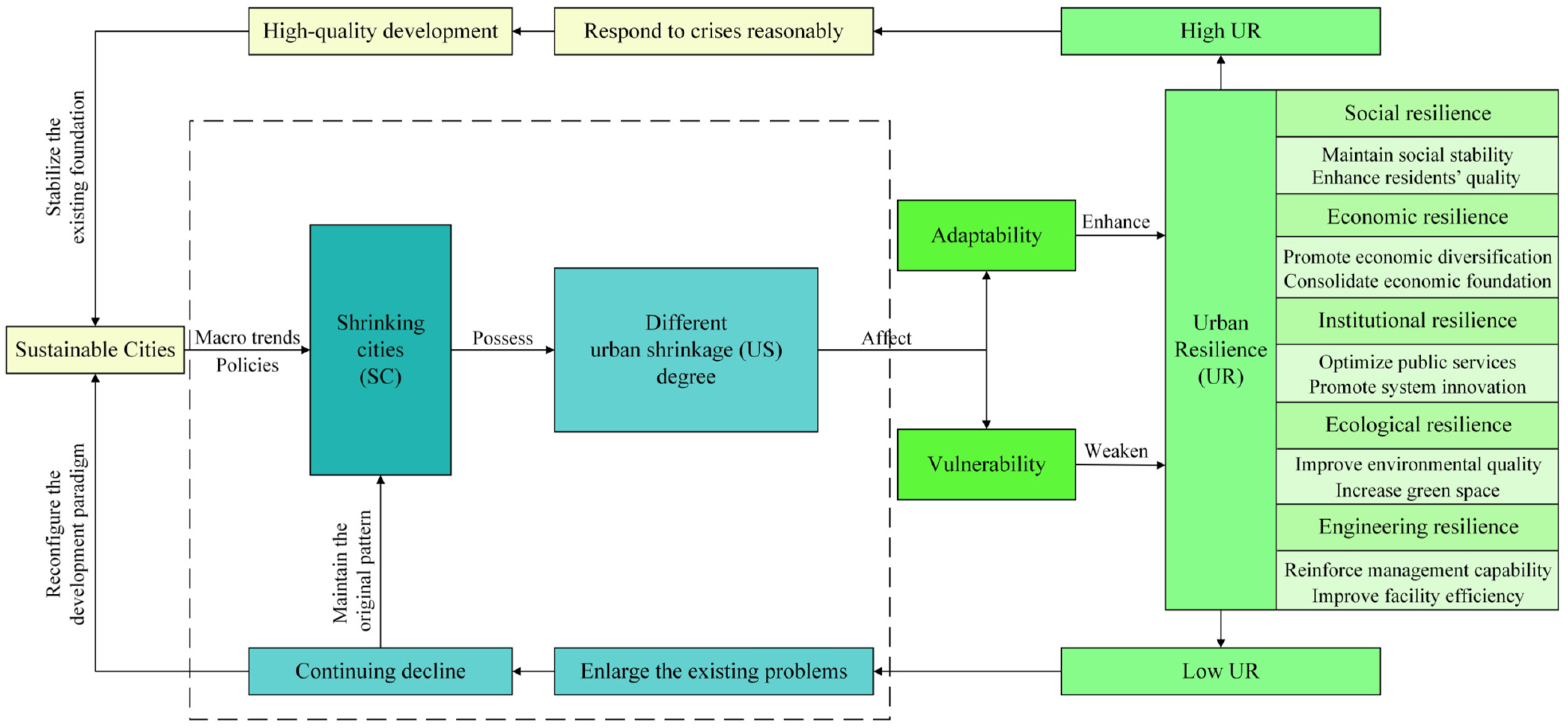
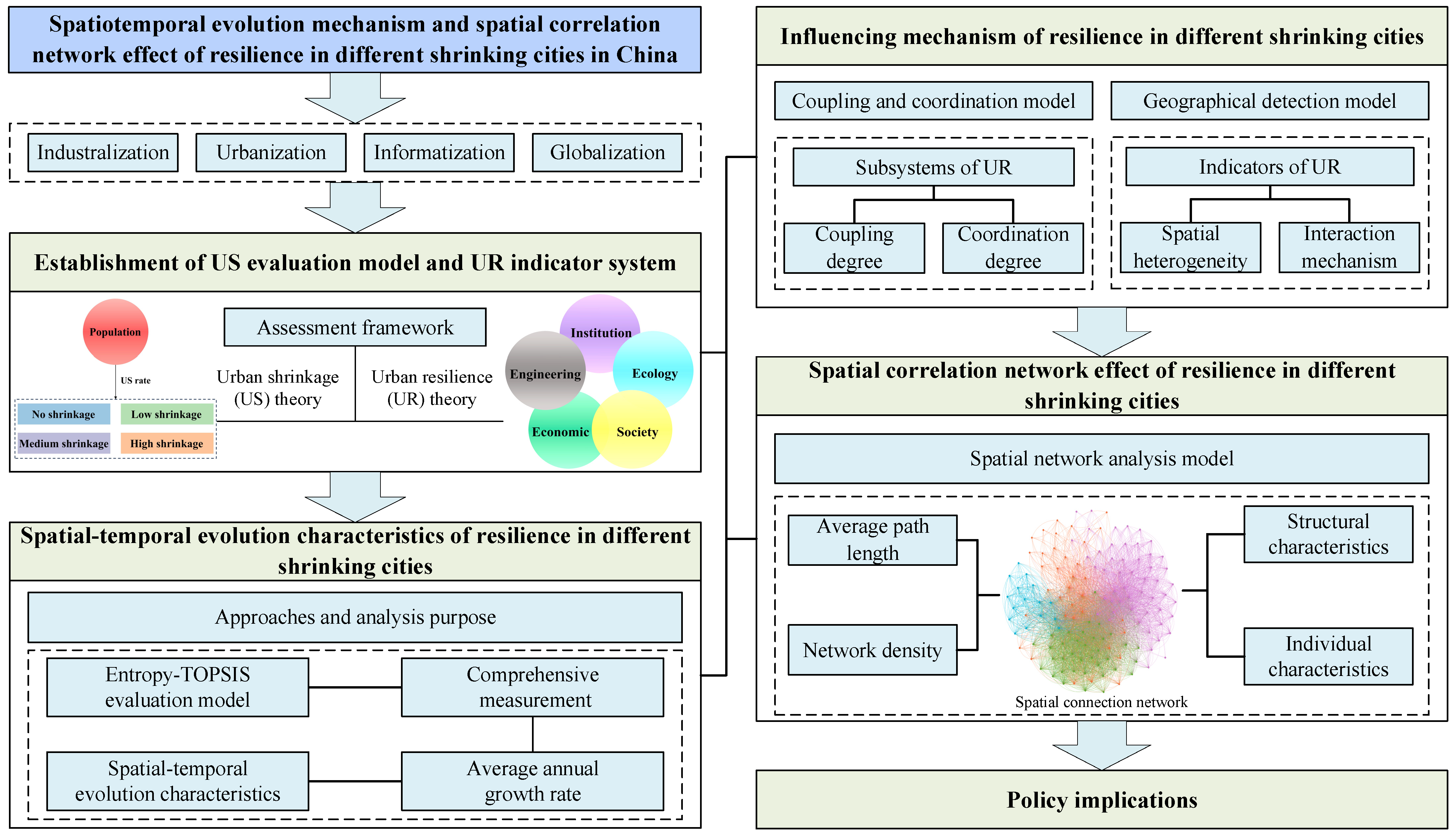


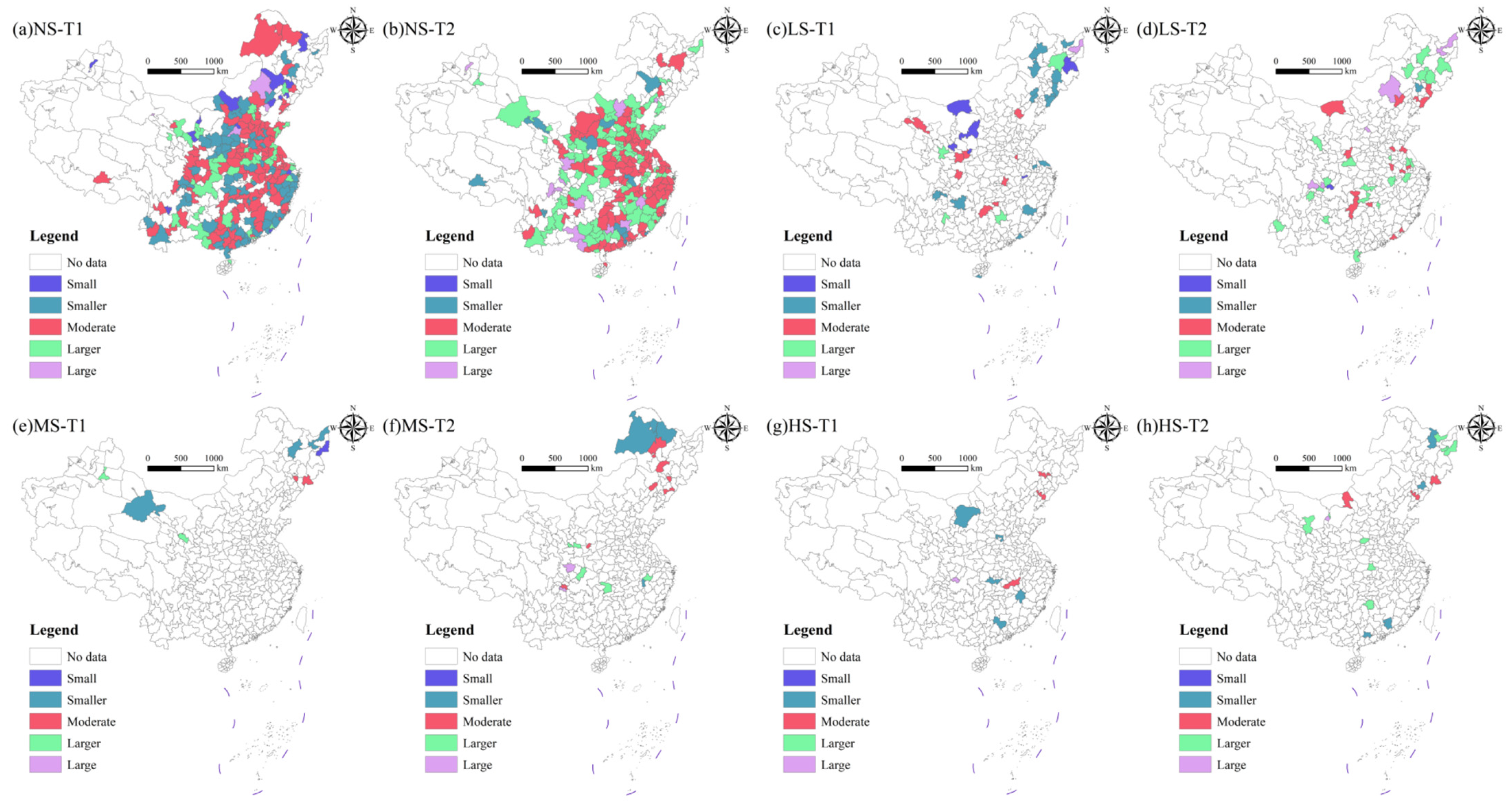

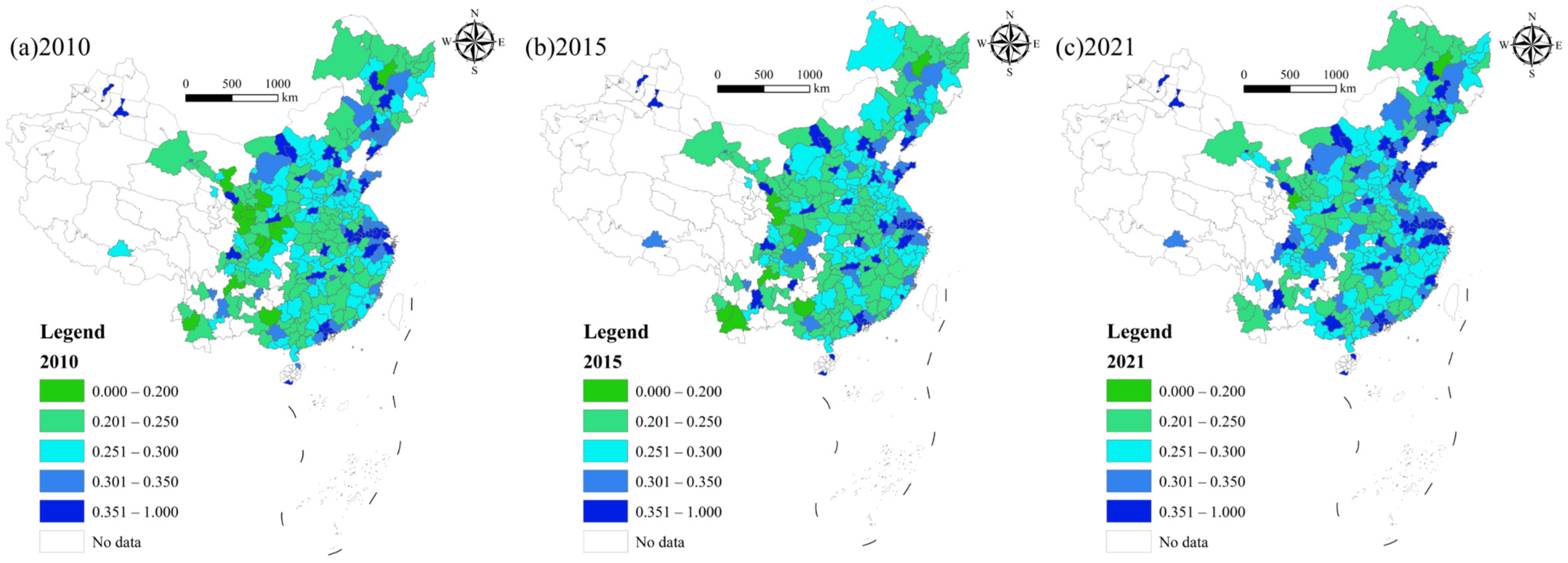
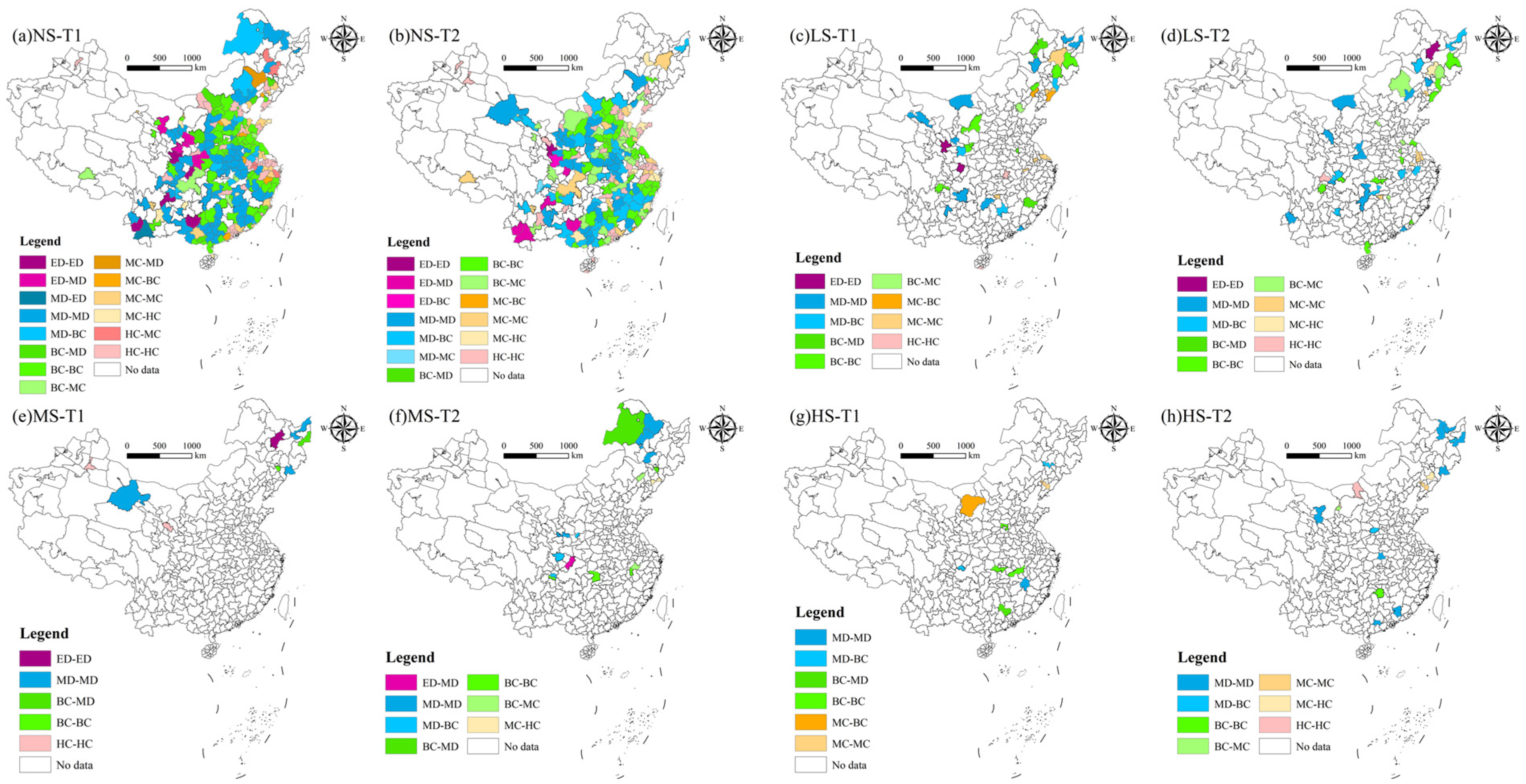
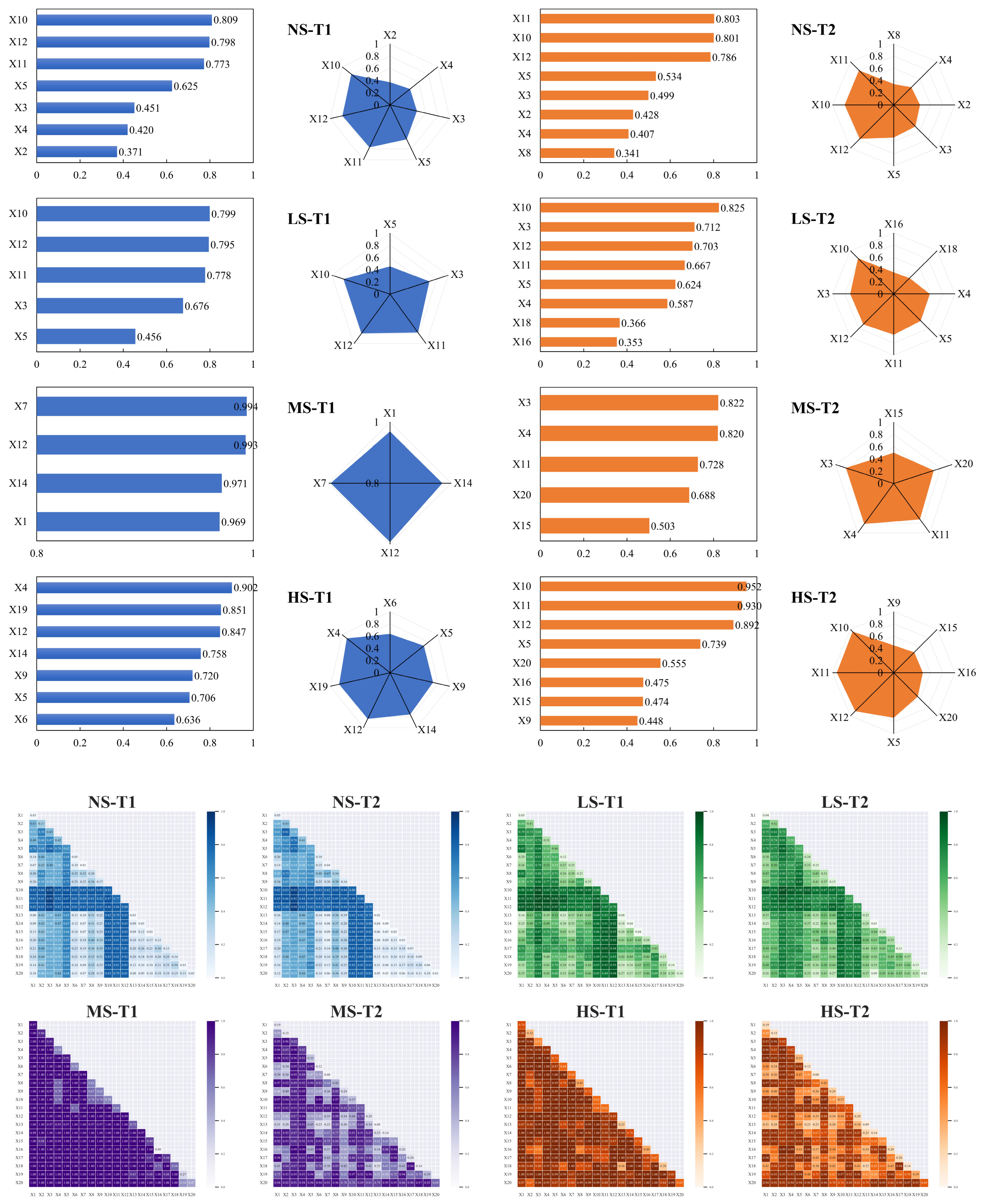
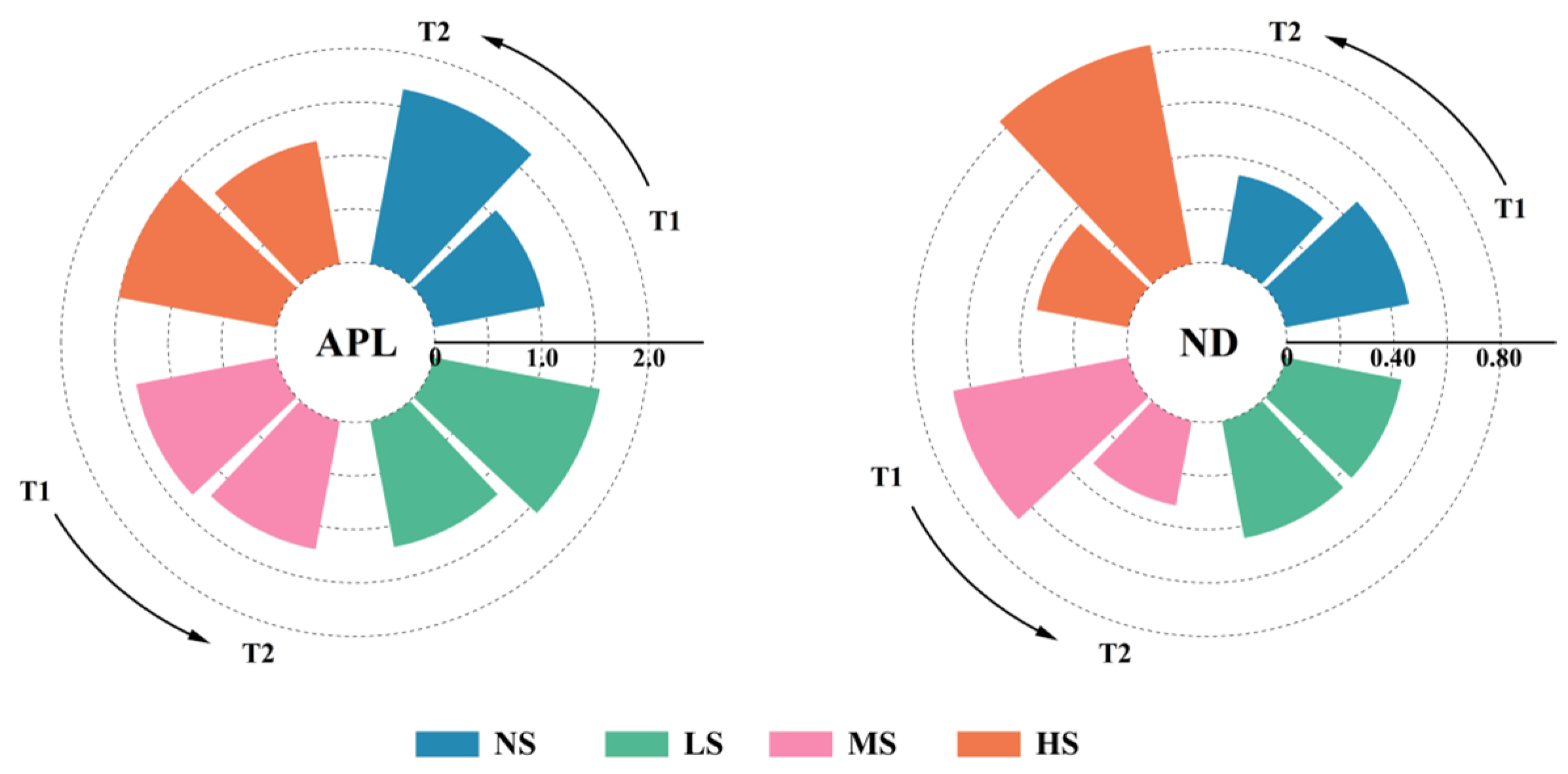
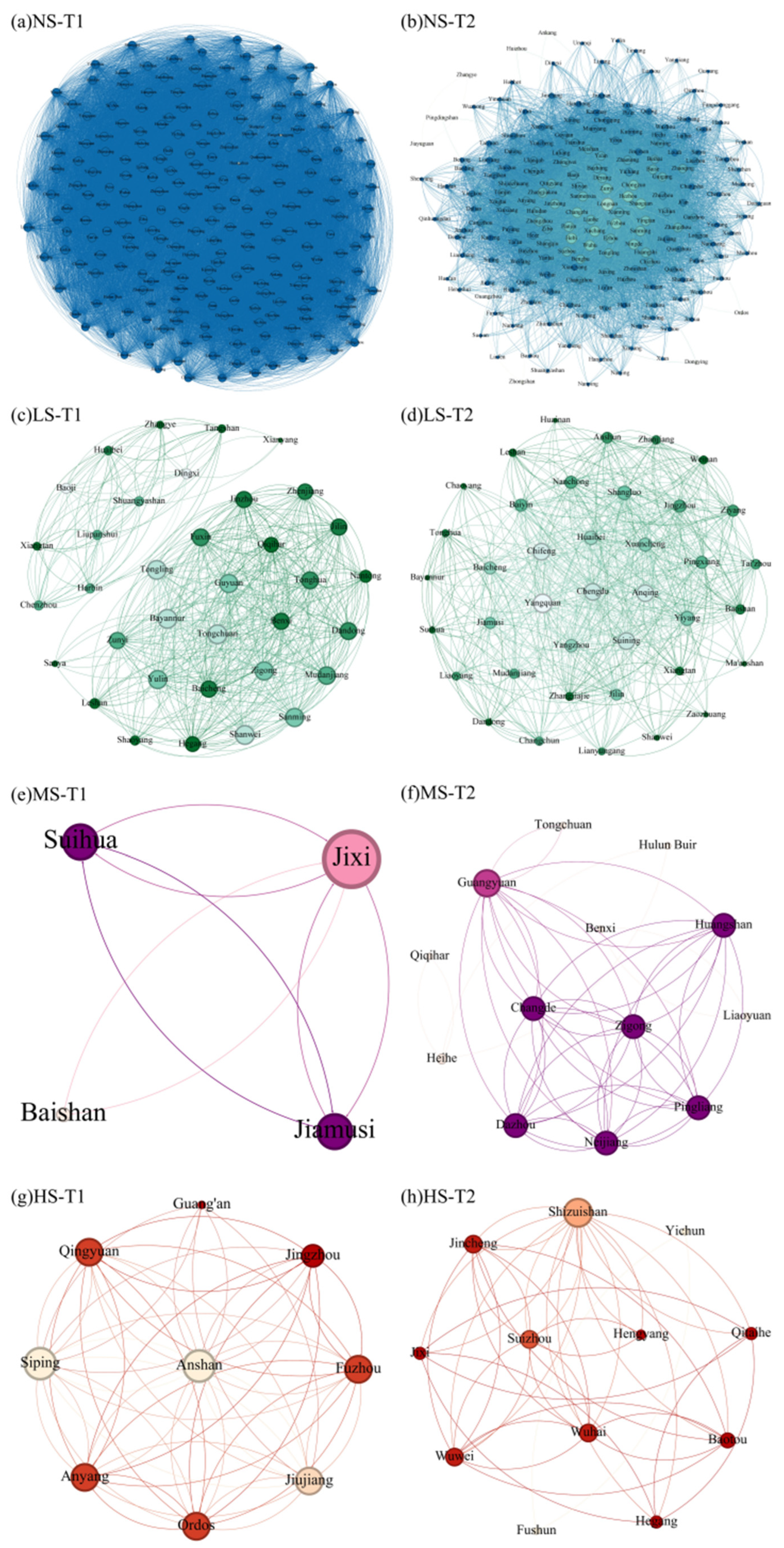
| The Degree of US | Division Standard |
|---|---|
| No shrinkage (NS) | ≥ 0 |
| Low shrinkage (LS) | −5% < ≤ 0 |
| Medium shrinkage (MS) | −10% < ≤ −5% |
| High shrinkage (HS) | ≤ −10% |
| First Level Indicator | Secondary Indicators | Units and Properties | Evaluation Content | Weight | References |
|---|---|---|---|---|---|
| Social resilience (SR) | Natural population growth rate (X1) | % (+) | Stability of the age structure of the population | 0.0114 | [65,66] |
| Population density (X2) | 10,000 people/km2 (+) | Population distribution | 0.1474 | [66,67] | |
| College students per 10,000 population (X3) | People/10,000 (+) | Individual capacity to cope with risk | 0.1423 | [68] | |
| Economic resilience (ER) | GDP per capita (X4) | CNY (+) | Personal economic strength | 0.0559 | [43,69] |
| Local fiscal self-sufficiency rate (X5) | % (+) | Local financial strength | 0.0494 | [70] | |
| Financial loan-to-deposit ratio (X6) | % (+) | Urban risk control capacity | 0.0220 | [71] | |
| Residents’ personal savings rate (X7) | % (+) | 0.0003 | [72] | ||
| Institutional resilience (IR) | Doctors and nurses employees per 1000 population (X8) | People/1000 (+) | Socio-medical motivation | 0.0412 | [73] |
| Number of beds per 1000 people in medical institutions (X9) | Beds/1000 people (+) | Social security capacity | 0.0278 | [74] | |
| Basic pension insurance participants at the end of the year (X10) | People/100 (+) | Social security needs | 0.1331 | [43,75] | |
| Basic medical insurance participants at the end of the year (X11) | People/100 (+) | 0.1393 | [76] | ||
| Basic unemployment insurance participants at the end of the year (X12) | People/100 (−) | 0.0025 | [77] | ||
| Ecological resilience (ECR) | Harmless disposal rate of domestic waste (X13) | % (+) | Municipal capacity to treat industrial waste | 0.0051 | [78,79] |
| Centralized treatment rate of sewage treatment plants (X14) | % (+) | 0.0064 | [80] | ||
| Comprehensive utilization rate of industrial solid waste (X15) | % (+) | 0.0171 | [81,82] | ||
| Greening coverage of the district (X16) | % (+) | Urban self-purification capacity | 0.0036 | [71,83] | |
| Engineering resilience (ENR) | Gas penetration rate (X17) | t/people (−) | Residential energy consumption capacity | 0.0043 | [84,85] |
| Water consumption per capita (X18) | t/people (−) | The perfection of urban infrastructure | 0.0048 | [86,87] | |
| Road area per capita (X19) | m2/people (+) | 0.0332 | [88,89] | ||
| Road freight per capita (X20) | t/people (+) | 0.1530 | [90,91] |
| CD | Type | Stage |
|---|---|---|
| C ∈ [0, 0.2] | Low Coupling | Lower Coupling stage |
| C ∈ (0.2, 0.3] | Antagonistic | |
| C ∈ (0.3, 0.4] | Moderate Coupling | Moderate Coupling stage |
| C ∈ (0.4, 0.5] | Running-in | Advanced Coupling stage |
| C ∈ (0.5, 1) | High Coupling |
| CCD | Type | Stage |
|---|---|---|
| D ∈ [0, 0.2] | Extreme Disorder (ED) | Disorder stage |
| D ∈ (0.2, 0.25] | Moderate Disorder (MD) | |
| D ∈ (0.25, 0.3] | Basic Coordination (BC) | Transition stage |
| D ∈ (0.3, 0.35] | Moderate Coordination (MC) | Coordination stage |
| D ∈ (0.35, 1] | High Coordination (HC) |
Disclaimer/Publisher’s Note: The statements, opinions and data contained in all publications are solely those of the individual author(s) and contributor(s) and not of MDPI and/or the editor(s). MDPI and/or the editor(s) disclaim responsibility for any injury to people or property resulting from any ideas, methods, instructions or products referred to in the content. |
© 2025 by the authors. Licensee MDPI, Basel, Switzerland. This article is an open access article distributed under the terms and conditions of the Creative Commons Attribution (CC BY) license (https://creativecommons.org/licenses/by/4.0/).
Share and Cite
Yu, W.; Zhang, S.; Pang, E.; Wang, H.; Yang, Y.; Zhong, Y.; Jing, T.; Zou, H. Spatiotemporal Evolution Mechanism and Spatial Correlation Network Effect of Resilience in Different Shrinking Cities in China. Land 2025, 14, 348. https://doi.org/10.3390/land14020348
Yu W, Zhang S, Pang E, Wang H, Yang Y, Zhong Y, Jing T, Zou H. Spatiotemporal Evolution Mechanism and Spatial Correlation Network Effect of Resilience in Different Shrinking Cities in China. Land. 2025; 14(2):348. https://doi.org/10.3390/land14020348
Chicago/Turabian StyleYu, Weijun, Siyu Zhang, Entao Pang, Huihui Wang, Yunsong Yang, Yuhao Zhong, Tian Jing, and Hongguang Zou. 2025. "Spatiotemporal Evolution Mechanism and Spatial Correlation Network Effect of Resilience in Different Shrinking Cities in China" Land 14, no. 2: 348. https://doi.org/10.3390/land14020348
APA StyleYu, W., Zhang, S., Pang, E., Wang, H., Yang, Y., Zhong, Y., Jing, T., & Zou, H. (2025). Spatiotemporal Evolution Mechanism and Spatial Correlation Network Effect of Resilience in Different Shrinking Cities in China. Land, 14(2), 348. https://doi.org/10.3390/land14020348







